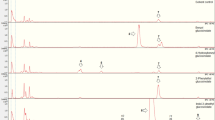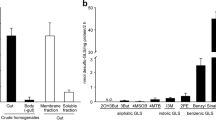Abstract
DURING investigations in this laboratory on the fate of foreign organic compounds in locusts, we wished to find out whether these insects formed conjugated glucuronic acids. In the higher animals, glucuronic acid conjugation appears to be a major detoxication mechanism particularly for hydroxy compounds1; but there appears to be no record in the literature of this mechanism occurring in invertebrates.
This is a preview of subscription content, access via your institution
Access options
Subscribe to this journal
Receive 51 print issues and online access
$199.00 per year
only $3.90 per issue
Buy this article
- Purchase on Springer Link
- Instant access to full article PDF
Prices may be subject to local taxes which are calculated during checkout
Similar content being viewed by others
References
Williams, R. T., “Detoxication Mechanisms” (Chapman and Hall, 1947).
Williams, R. T., Biochem. J., 37, 329 (1943); Smith, J. N. (unpublished data).
Robinson, D., Smith, J. N., and Williams, R. T., Biochem. J., 53, 125 (1953).
Hill, R., Ann. Rep. Chem. Soc., 37, 434 (1940). Pigman, W. W., and Goepp, R. M., “Chemistry of the Carbohydrates”, 509 (Academic Press, Inc., New York, 1948).
Latham, H. G., May, E. L., and Mosettig, E., J. Org. Chem., 15, 884 (1950).
Author information
Authors and Affiliations
Rights and permissions
About this article
Cite this article
MYERS, C., SMITH, J. Formation of Glucosides from Phenols in Locusts. Nature 172, 32–33 (1953). https://doi.org/10.1038/172032a0
Issue Date:
DOI: https://doi.org/10.1038/172032a0
Comments
By submitting a comment you agree to abide by our Terms and Community Guidelines. If you find something abusive or that does not comply with our terms or guidelines please flag it as inappropriate.



